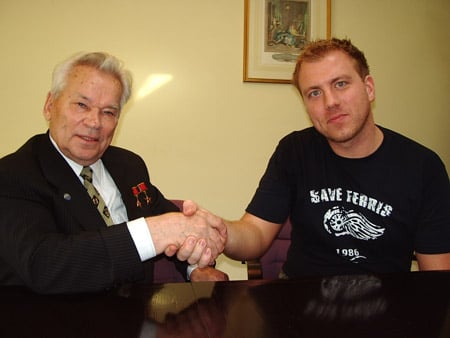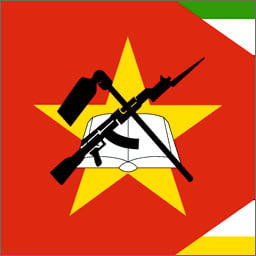Original URL: https://www.theregister.com/2007/08/03/ak_47_60_years/
AK47: the open-source weapon that took the world by storm
More like communism than Linux
Posted in Science, 3rd August 2007 15:35 GMT
Feature Sixty years ago, a former tank sergeant named Mikhail Kalashnikov submitted an assault-rifle design to the Red Army for trials. It was selected as the new personal weapon for most Soviet soldiers, and designated Automat Kalashnikova 1947 – AK47 for short. That designation went out of official use in 1959, but to this day “AK47” is probably the world's most widely-known gun name. Just as open-source Linux - the "communist" software, according to Steve Ballmer - has made Linus Torvalds famous, the genuinely communist open-source AK has given Mikhail Kalashnikov a profile at least as high. The AK47 and its successor designs are the most widely-used firearms on the face of the planet.

El Reg meets the general.
The ubiquitous AK has been seen as one of the most influential pieces of technology produced in the 20th century. People have made amazing claims for it: the Kalashnikov is said to have humbled US military and economic power, to have liberated the downtrodden and oppressed, to have changed the very face of warfare. Dozens of books have been written about the AK phenomenon, hundreds or perhaps thousands of articles.
Only one thing has been lacking in the AK discussion. That is, analysis from the debatable borderlands where technology, social phenomena and enormous, rumbling, erratically-researched commentary/analysis spitball articles collide: the land of Vulture Central. But today it shall lack no more.
The Nazis were arguably the first to field an assault rifle in significant numbers (See the Reg gun-dork primer here), but they dropped out of the picture in 1944. The Russians didn't: which is where Mikhail Kalashnikov and the AK47 come in.
By the end of World War Two, the Red Army had become enormous. Its millions of short-service, poorly trained conscript soldiers were largely armed with cheap submachineguns knocked out in a hurry. As the Soviets squared up to the Western powers, they knew that their troops – and those of their client nations – would need better weapons. They decided on an intermediate-power cartridge, so as to minimise costs and maximise capability. Having a very low level of marksmanship among their forces, they weren’t much concerned with accuracy or range.
The design they chose was the AK47, firing intermediate-poke Soviet 7.62mm cartridges, and it couldn't have fulfilled the requirement better. The AK could hit targets out to perhaps 200-300m. (AK47 sights are adjustable to 800m, later increased to 1000m on the AKM, but this is wildly optimistic.) The new weapon could spray bullets efficiently on full automatic, seldom suffering a stoppage. It was simple to strip and maintain, and worked pretty well even without any maintenance, covered in mud, dirt or rust. Best of all, it could be made very cheaply and easily.

The original AK47.
The AK47 was a solid design to begin with, and it was continuously developed. The design was refined in 1951, and again in 1959. Strictly speaking, Russian AKs after 1959 were no longer AK47s but AKMs – Automat Kalashnikova Modernizirovannyj (Modernised). The AKM isn’t much different from a classic AK47 as far as the user is concerned, but it's even cheaper to make.

The AKM of 1959. Not actually a big difference.
Kalashnikov and his successors did an excellent job on the AK, but even so it has its faults. It's less accurate than an assault rifle really should be; in many cases only a little better than a submachinegun. The safety catch/selector switch is comparatively difficult and noisy to operate: and the bolt doesn't lock open when the magazine is empty, so that a round must be chambered manually after each reloading. For the user, the AK is good-enough rather than actually good.
So why is it so wildly popular, manufactured and used in the scores of millions? And why do people attribute such legendary qualities to what is, in the end, a very basic piece of kit? It isn’t at all uncommon to find people saying that the AK47 was a big factor in America’s Vietnam defeat, or that it freed various oppressed peoples from colonial dominance. Commentators – usually journalists rather than gun nuts or soldiers - have suggested that the “People’s Gun” is some sort of phenomenon in its own right, that handing a Kalashnikov – only a Kalashnikov – to a barefoot peasant (or even a child) makes him or her miraculously capable of defeating expensively trained and equipped professional soldiers.
One factor here is probably that the AK was an early example of open-sourcing. The Soviets published full technical and manufacturing specs to friendly countries worldwide, requiring no payments or licencing. The Eastern-European Soviet bloc states all made their own, and the Chinese churned out enormous numbers. The so-called “AK47s” used by the Viet Cong and People’s Army of Vietnam against the Americans were usually – strictly speaking – the Chinese Type 56 copy, and this has often been the case elsewhere as well. Some analysts reckon that the Type 56 is actually the most widely-distributed AK variant.

The Chinese Type 56 copy. If you got shot by Charlie in 'Nam,
he was probably using one of these.
Another reason that the AK established such an early dominance is that for a long time it was the only true assault rifle widely available. In the years immediately after World War Two, America essentially rejected the assault rifle concept. US forces had fought the war with a variety of personal weapons, including a semi-automatic carbine which was very close to being an assault rifle. However, the arm which found favour with post-war US generals was the M1 Garand, a full-power rifle of the semi-automatic or “self-loading” type – ie, it fired one shot per trigger pull without any need to work the bolt manually.
Perhaps reasoning that the German “assault rifle” concept couldn’t have been so all-fired clever or the Germans would have won the war*, the Americans compelled NATO to adopt a standard rifle cartridge which was basically an old school full-power rifle round. This was NATO 7.62mm, the same calibre as the ammo for the AK but much more powerful. The Americans modified their M1 Garand slightly to take this new ammo, renaming it the M-14, and carried on happily for another decade or so. Various new kinds of rifle were designed in Europe to use the new NATO 7.62mm cartridge, including refined versions of the original Nazi MP/StG-44, but these were by necessity fairly long, heavy, expensive and potentially accurate to quite long ranges. They are usually called “battle rifles” rather than assault rifles. One of the most famous is the Belgian FAL, known in British service as the Self-Loading Rifle, or SLR.**
Battle rifles were still over-spec’d for the marksmanship skills of the average professional soldier, let alone those of the average conscript, guerilla or insurgent, and they were still a bit long and heavy for closeup scrapping. Furthermore, they were pricey compared to AKs: and neither they or their ammo were widely available. They could be – often were – made under licence by foreign factories, but this cost money and was sometimes forbidden by Western governments.
For twenty years or so, then, the AK was the only true assault rifle made in any numbers. It was also the only modern personal weapon of any kind available cheaply and freely to a large proportion of the world’s combatants. As it happens the AK is a more than decent design, but whichever rifle the Soviets chose in 1947 to fire their new intermediate cartridge would probably have become near-universal in these circumstances. Mikhail Kalashnikov didn’t exhibit any genius-like skills; his design didn’t change the world of itself.
Eventually the Americans, embroiled in the jungles of Vietnam against AK-toting commies, decided that they liked controllable automatic fire more than long range after all, and adopted an intermediate-power cartridge at last – NATO 5.56mm – and a true assault rifle to fire it from. The new gun was based on the AR-15 pattern but became much more widely known under its US military designation, M-16.
The M-16 had terrible teething troubles, which served to further enhance the reputation of the AK. Rumours circulated that the M-16 didn’t need cleaning, supported by the fact that it was initially issued without a cleaning kit. Unfortunately, the Pentagon had chosen to use a non-recommended propellant powder in the 5.56mm ammo, which was especially prone to clog the guns up. On top of all this, as the Vietnam War progressed and the M-16 came into widespread service, the morale and commitment of US troops – mostly unwilling two-year conscripts with no desire to fight or to be good soldiers - plunged to rock bottom.
Unsurprisingly, by the time the less dope-addled American grunts began cleaning their rifles again and the cartridge powder got sorted out, the M-16 had a frightful rep for unreliability. This is where the legend of the AK probably got its first real start, as various Western soldiers and commentators derided the new American “Mattel Toy,” and lauded the AK.
*Though statistically it had taken several Yanks or Brits to subdue each German.
**Another insane piece of gun phraseology. In the British forces, the command “Load” means “insert a fresh magazine (clip, in American) of bullets into the weapon,” as in “with a magazine of twenty rounds – Load.” The old Self-Loading Rifle/SLR was a good gun, but it couldn’t actually change magazines on its own, as its British name would imply to a British user. Your correspondent pointed this out to a training sergeant long ago, and was commended for his perspicacity before being invited to bash out a quick thirty press-ups.
Interestingly, the Russians themselves didn’t entirely agree. In 1974, the year before the fall of Saigon, they came out with a new version of the AKM, designed to take a new, small-calibre intermediate round – 5.45mm Soviet, not dissimilar to 5.56mm NATO. Thus, the commies had effectively admitted that US small-arms technology was superior to the AK as it then stood.
Small-calibre intermediate rounds like these are said to be just as lethal as old-style 7.62mm Soviet, and they weigh less; which allows more to be shipped and carried. Ever since, the main army rifle of the USSR and then Russia has been the AK-74. Kalashnikov’s design lived on – the AK-74 is still a very recognisable AK descendant - but the famous AK-47 had effectively been superseded, just as it was gaining worldwide fame.
Meanwhile, the allegedly rubbish M-16 went from strength to strength. M-16s in one form or another are still almost universal issue for the US forces and many others. Even more tellingly, M-16 variants are the most commonly chosen assault rifle of Western special-forces units, including the British SAS and SBS. These people are able to select any weapon they like, almost regardless of expense; the M-16 wouldn’t be on their shopping list if it wasn’t one of the best designs available. (Though it’s also quite true that the sneaky elites will frequently carry AKs. This is typically more from a wish to avoid being recognized than because of the weapon’s merits.)
Despite the introduction of the AK-74 in Russia and the fact that the M-16 is actually pretty good, the legend of the original Kalashnikov refused to die. In fact it grew and spread throughout the world, to the point where no other gun has the same degree of recognition. The new 5.45mm Soviet ammo never became as widely available as 7.62mm Soviet, and the AK-74 never really took off globally the way the AK-47, AKM and their various copies did, though Osama bin Laden seems to personally favour the cut-down AKS-74U. To this day, if a Western – or a Russian – soldier gets hit by an enemy bullet, it will normally be a 7.62mm-Soviet round from an old-school AK.

Osama is often pictured with an AKS-74U stubby.
In keeping with open-source principles, Mikhail Kalashnikov never made any money from his design directly, though he did gain the rank of General. Since retirement, he has also lent his name to the marketing of “Kalashnikov” branded vodka, presumably planned to sell at an inflated price in the same way that Porsche sunglasses or Ferrari man-perfume does. The good General gave us his thoughts on Vodka, guns and Russian courage, which you can read here.
The amazing, continued escalation of AK47 hype has certainly not gone away. There have been at least two books just in the past couple of years, and authors or reviewers have described the sixty-year-old shooter as “the weapon that changed the face of war,” “the single most deadly weapon ever produced,” “A force in itself,” and even "a flamboyant symbol of masculinity,” god help us.

The national flag of Mozambique has an AK on it.
In classic bonehead style, one American librarian refers to it as “this simple submachine gun ... a superior weapon to the American M-16 ... [which is] an inferior, lightweight machine gun,” no doubt causing many an eye to roll among the gun-dweeb community.
Izhmash, the commercial arms concern descended from the Soviet small-arms apparats, nowadays holds rights to the AK designs. Like General Kalashnikov, the firm has given up the old-school open source philosophy of communist days, and is engaged in attempts to get licencing income from overseas. The Russian weaponeers, after failing to win any wide adoption even in Russia for the overly-fancy new AN-94 in the 1990s, have now bowed to the inevitable and are once again offering basic 7.62mm-Soviet AK-style weapons for export and licencing.
Venezuelan strongman Hugo Chavez last year purchased a hundred thousand “AK-103s,” almost indistinguishable from old-time AKMs, and plans to build a factory in Venezuela to make more. This could be seen as socialist fashion triumphing over practicality, but on the other hand a lot of people have never been very convinced about the deadliness of modern 5 ½ mm slugs. Meanwhile, plenty of people all over the world are still settling their disputes with the original article.
The AK-47 isn’t what people claim for it. It’s far from unique; it doesn’t miraculously make peasants into soldiers; it didn’t change the face of battle. Vietnamese peasants would have driven demoralised US draftees back across the sea without it. The horrors of modern Africa, child soldiers and all, owe more to machetes and tribal hatred than to any kind of firearm. Automatic fire isn’t the big deal everyone thinks; competent gunmen normally fire individual aimed shots.
But the Kalashnikov is a perfectly good design; and more than that, it’s fashionable. The AK-47 is dead; long live the AK-47. ®